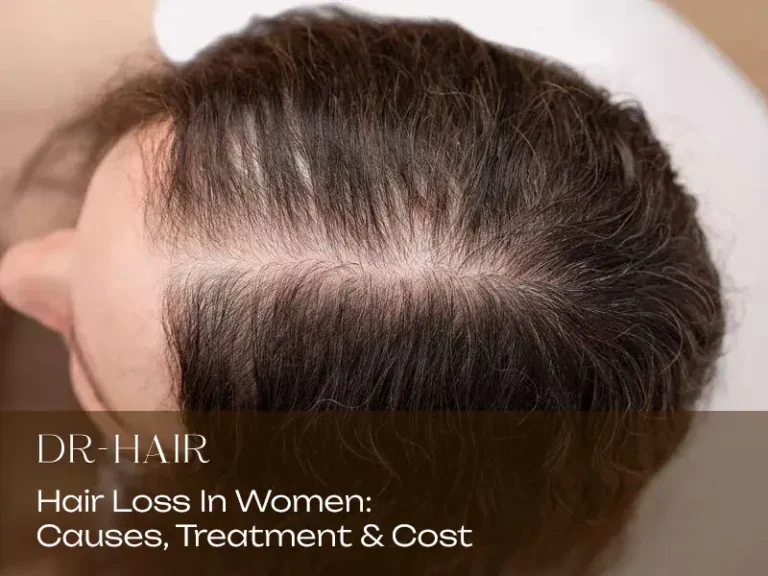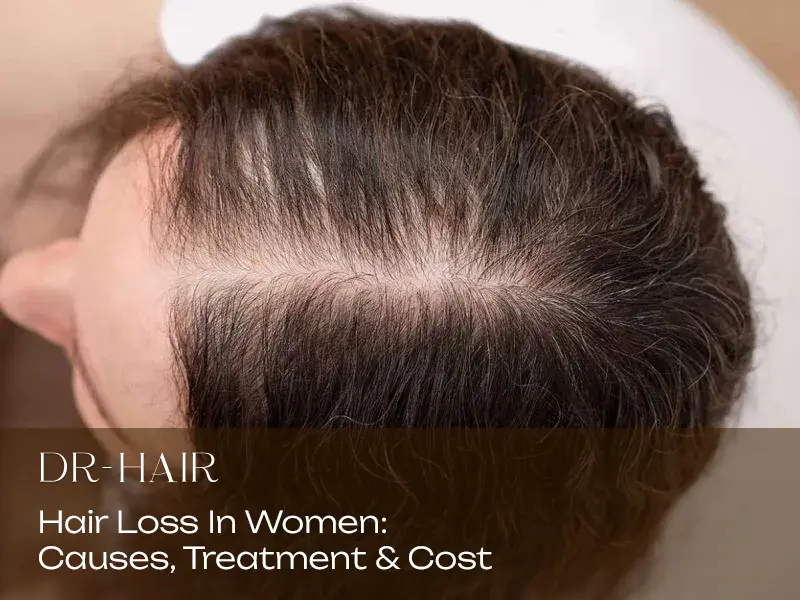Hair Loss In Women
Hair loss, or alopecia, is often associated with men, but it is a common problem among women as well. In fact, it’s estimated that nearly 40% of women experience some degree of hair thinning or hair loss at some point in their lives. The causes of hair loss in women can be varied, and the treatments available range from medical solutions to lifestyle changes. This article will explore the causes of hair loss in women, available treatments, and preventive measures
Causes of Hair Loss in Women
Hair loss in women can occur due to a variety of reasons, from hormonal changes to stress and genetics. Understanding the underlying cause is crucial in determining the most effective treatment. Below are the common causes:
1. Hormonal Imbalances
One of the most significant factors contributing to hair loss in women is hormonal changes, which often occur during pregnancy, childbirth, menopause, or due to conditions such as polycystic ovary syndrome (PCOS). During pregnancy, for instance, women often experience thicker hair due to increased estrogen levels, but once the baby is born and hormones return to normal, hair shedding can occur.
2. Genetics
Genetics play a significant role in hair loss, particularly a condition called androgenetic alopecia, commonly known as female pattern baldness. This type of hair loss is hereditary and tends to occur gradually. It is characterized by thinning hair on the scalp, especially along the crown and at the parting.
3. Nutritional Deficiencies
A lack of certain nutrients, particularly iron, zinc, vitamin D, and biotin, can lead to hair thinning and hair loss. A well-balanced diet is essential for maintaining healthy hair, and deficiencies in essential vitamins and minerals can hinder hair growth.
4. Stress and Trauma
Physical or emotional stress can cause temporary hair loss, known as telogen effluvium. This condition can occur after a traumatic event, such as surgery, an accident, or a stressful life event. Stress disrupts the hair growth cycle, leading to excessive shedding.
5. Medical Conditions and Medications
Certain medical conditions, such as thyroid disorders, autoimmune diseases, and anemia, can lead to hair loss in women. Additionally, medications for conditions such as cancer, depression, or high blood pressure can also contribute to hair thinning. Chemotherapy is particularly well-known for causing hair loss.
Treatment Options for Hair Loss in Women
Treating hair loss in women depends on its underlying cause. There are several treatments available, ranging from non-invasive options to medical interventions.
1. Minoxidil (Rogaine)
Minoxidil is an over-the-counter topical treatment that can stimulate hair growth. It’s FDA-approved for use in both men and women and works by improving blood flow to the hair follicles, thus promoting hair growth. It is applied directly to the scalp twice daily. While it does not work for everyone, many women find it effective in reducing hair thinning and promoting regrowth.
2. Hormonal Therapy
If hormonal imbalances are causing hair loss, hormonal therapy may be an option. For women who experience hair loss due to menopause or PCOS, doctors may recommend birth control pills or anti-androgens, such as spironolactone, to help balance hormones and reduce hair loss.
3. Platelet-Rich Plasma (PRP) Therapy
PRP therapy involves drawing a small amount of the patient’s blood, processing it to concentrate the platelets, and then injecting it into the scalp. The growth factors in the platelets can stimulate hair follicles to promote new hair growth. PRP therapy has gained popularity in recent years for its potential to improve hair density and thickness.
4. Hair Transplant Surgery
For women with severe hair loss or female pattern baldness, hair transplant surgery may be considered. This procedure involves taking hair follicles from areas of the scalp where hair is still thick and transplanting them to areas with thinning hair. While effective, this is a more invasive option.
5. Diet and Lifestyle Changes
Improving your diet and managing stress can help prevent or reduce hair loss. Ensuring adequate intake of essential nutrients, such as vitamins A, B, C, D, and E, along with omega-3 fatty acids, can help promote healthy hair growth. Reducing stress through relaxation techniques, such as yoga or meditation, may also help reduce the risk of hair loss.
Preventing Hair Loss in Women
While some causes of hair loss cannot be avoided, there are steps you can take to minimize the risk of excessive shedding and thinning:
Avoid Tight Hairstyles: Hairstyles like ponytails, braids, and buns can cause tension on the hair and lead to traction alopecia. Opt for looser styles that don’t put too much pressure on the hair follicles.
Be Gentle with Your Hair: Avoid harsh brushing, excessive heat styling, and chemical treatments that can damage the hair and lead to breakage.
Maintain a Balanced Diet: Ensure that your diet includes adequate nutrients to support hair health. Include plenty of fruits, vegetables, and protein-rich foods.
Manage Stress: Since stress can trigger hair loss, practicing stress-management techniques is essential. Regular exercise, mindfulness practices, and adequate sleep can all help reduce stress levels.
Regular Scalp Care: Gently massaging the scalp can help stimulate blood circulation to the hair follicles and encourage hair growth. Using gentle shampoos and conditioners will also keep your hair healthy.
FAQs About Hair Loss in Women
1. What are the most common causes of hair loss in women? The most common causes of hair loss in women are hormonal imbalances, genetics (female pattern baldness), nutritional deficiencies, stress, and medical conditions such as thyroid disorders.
2. Can hair loss in women be reversed? In many cases, hair loss can be reversed or at least slowed down with the right treatment. Topical treatments like Minoxidil, lifestyle changes, and medical therapies can help promote hair regrowth and prevent further loss.
3. Is PRP therapy effective for hair loss in women? PRP therapy can be effective for some women, particularly those experiencing hair thinning. The growth factors in the platelets may stimulate hair follicles, improving hair density and thickness. However, results can vary from person to person.
4. How can I prevent hair loss in the future? Preventing hair loss involves maintaining a healthy diet, managing stress, avoiding tight hairstyles, and using gentle hair care products. Regular scalp massages and proper hair care practices can also help reduce the risk.
Conclusion
Hair loss in women is a common concern, but with the right understanding of its causes and available treatments, it is possible to manage and even reverse the condition in many cases. Whether it’s through medical treatments like Minoxidil and PRP therapy, lifestyle adjustments, or more invasive options like hair transplant surgery, there are several ways to address hair loss. Additionally, with proper care and attention, many women can prevent further thinning and enjoy a full, healthy head of hair.

